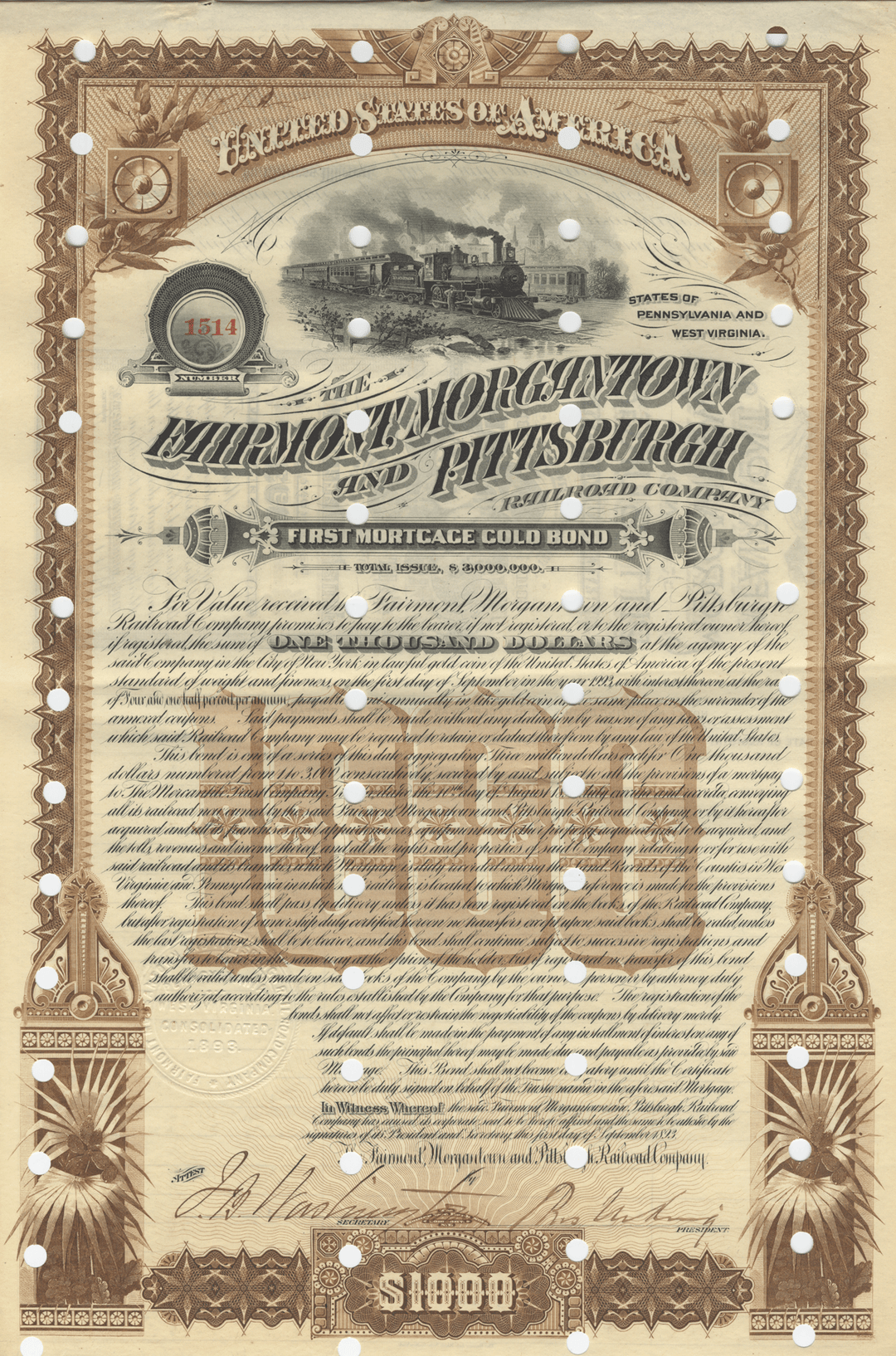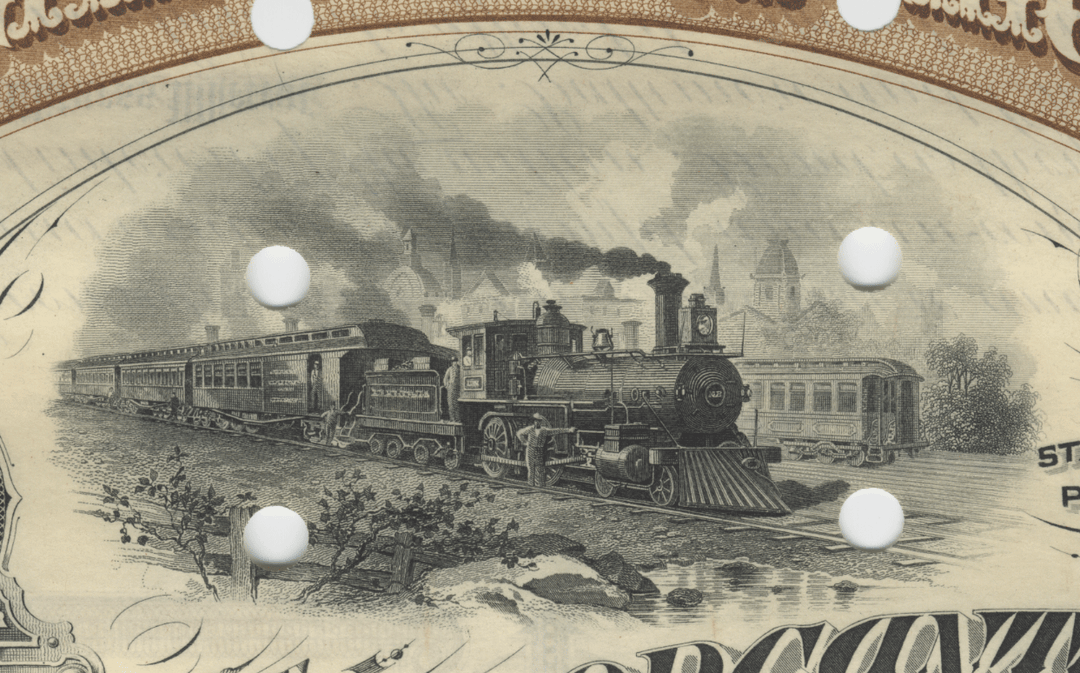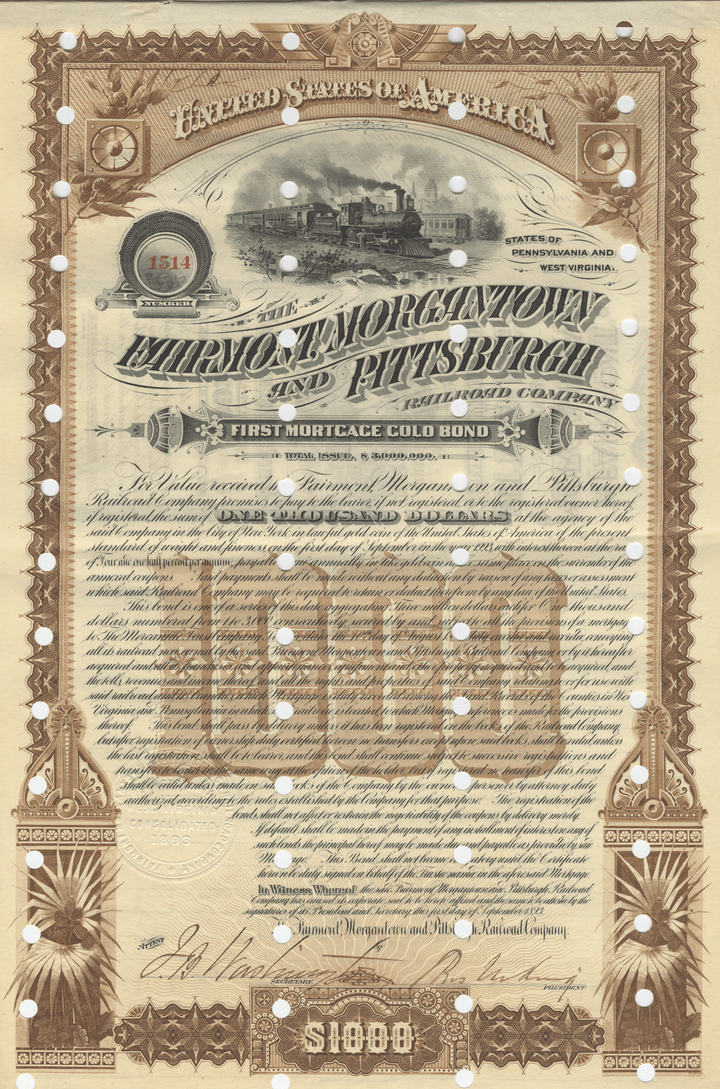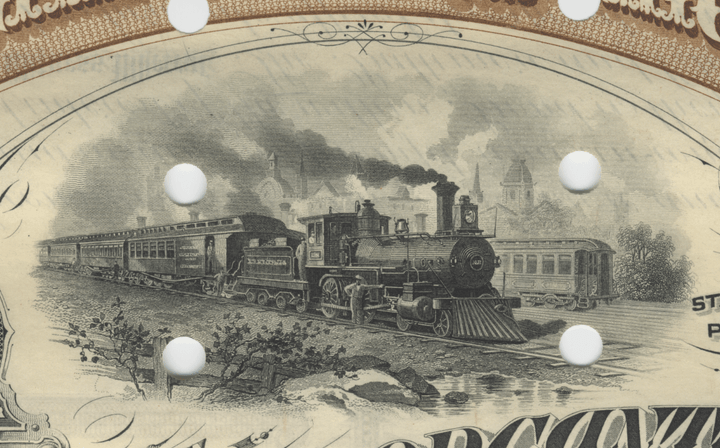Fairmont, Morgantown and Pittsburgh Railroad Company (Signed by Orland Smith)
- Guaranteed authentic document
- Orders over $75 ship FREE to U. S. addresses
Product Details
Company
Fairmont, Morgantown and Pittsburgh Railroad Company
Certificate Type
First Mortgage Gold Bond
Date Issued
September 1, 1893
Canceled
Yes
Printer
Homer Lee Bank Note Company
Signatures
Hand signed
Approximate Size
9 3/4" (w) by 14 1/2" (h)
Images
Representative of the piece you will receive
Guaranteed Authentic
Yes
Additional Details
Signed by Orland Smith
Historical Context
The Fairmont, Morgantown and Pittsburgh Railroad Company was incorporated in West Virginia on December 10, 1883 to construct a railroad from Morgantown.
The railroad, apparently backed from the start by the Baltimore & Ohio Railroad (B&O), was created to extend the B&O's line from Fairmont to Morgantown, and also to connect with the B&O line at Uniontown, Pennsylvania. Construction of the route was delayed by legal disagreements with the West Virginia & Pittsburgh Railroad over right of way rights -- in 1884 at Fairmont, and later at Point Marion and along the Cheat River, where there was room for only one railroad.
The railroad line was finally opened to South Morgantown by January 30, 1886, and to Morgantown a few days later, but by this time the railroad was operated and controlled by the B&O. The extension of the railroad from Morgantown to Uniontown, on which grading began in the spring of 1892, was practically completed early in 1894; and after some delay occasioned by the bridge across Cheat River at Point Mason, was opened to traffic the following summer -- soon resulting in the opening of many new coal mining operations in the Fairmont Coal Field and Monongalia County.
Orland Smith

Orland Smith (May 2, 1825 – October 3, 1903) was a railroad executive and a brigade commander in the Union Army during the American Civil War. In 1864, he led a spirited bayonet charge during the Battle of Wauhatchie that took a significant Confederate position on a hill that now bears his name.
Smith was born in New England in Lewiston, Maine. He was educated in the local schools and became a railroad agent, serving as station manager at Lewiston until 1852 when he moved to Ohio. He became an official of the Marietta and Cincinnati Railroad and settled in Chillicothe, Ohio. When the railroad fell into financial difficulties, he was appointed receiver. Smith was a lieutenant and commander of a militia company known as the "Chillicothe Greys."
With the outbreak of the Civil War, Smith joined the Union army and became the colonel of the 73rd Ohio Infantry, a regiment that was raised in Chillicothe in November 1861 and trained at nearby Camp Logan. Among his volunteer soldiers was Pvt. George Nixon III, the great-grandfather of future President Richard Nixon. Smith and his regiment saw action in western Virginia, fighting at the Battle of McDowell and the Battle of Cross Keys. During the late summer, as a part of the Army of Virginia, the 73rd OVI fought at the Second Battle of Bull Run near Manassas, Virginia.
Smith assumed brigade command in the XI Corps on October 25, 1862, but he did not participate in the Battle of Chancellorsville. He returned to his command shortly before the Gettysburg Campaign, after Brig. Gen. Francis C. Barlow, who had led the brigade at Chancellorsville, was given command of the 1st Division on May 24, 1863. Smith's men held Cemetery Hill on the first day of the Battle of Gettysburg at the orders of MG Oliver O. Howard, and provided an anchor for the retreating Federal soldiers. On the second day, three of Smith's regiments were engaged in heavy skirmishing in front of Cemetery Hill, and the 33rd Massachusetts, deployed between East Cemetery Hill and a knoll on the McKnight farm, helped repulse an evening attack by Col. Isaac E. Avery's North Carolina brigade.
Smith's Brigade was sent to the Western Theater in the autumn of 1863 along with the rest of the XI Corps. During the Chattanooga Campaign, Smith led his brigade in the Army of the Cumberland in a successful bayonet assault up a steep hill that now bears his name (Smith's Hill) during the Battle of Wauhatchie. In the army reorganization later that year, his brigade was disbanded and Smith returned on January 3, 1864 to the command of the 73rd OVI. He resigned his colonelcy on February 17, 1864. In the omnibus promotions at the close of the Civil War, Smith was appointed a brevet brigadier general dating from March 13, 1865.
After the war, he returned to his career as a railroad officer and became President of the Cincinnati, Washington and Baltimore Railroad and later, First Vice President of the Baltimore and Ohio Railroad. From 1884 to 1899 he was President of the Columbus and Cincinnati Midland Railroad.
Smith died in Chicago, Illinois. He is buried in Green Lawn Cemetery in Columbus, Ohio.
Related Collections
Additional Information
Certificates carry no value on any of today's financial indexes and no transfer of ownership is implied. All items offered are collectible in nature only. So, you can frame them, but you can't cash them in!
All of our pieces are original - we do not sell reproductions. If you ever find out that one of our pieces is not authentic, you may return it for a full refund of the purchase price and any associated shipping charges.









